|
|
|
Increase Font Size
Decrease Font Size
Monday, 2 May 2005
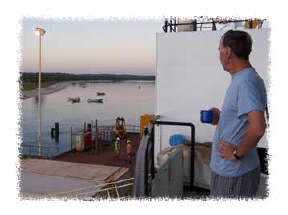 The ship travelled through the night and arrived at Seisia in the early hours of
Monday morning. We had breakfast on board before being allowed ashore. The jetty
at Seisia lays claim to be "Australia's Best Fishing Jetty." The locals
certainly believed in it and had their lines out well before the day had turned too hot.
The ship travelled through the night and arrived at Seisia in the early hours of
Monday morning. We had breakfast on board before being allowed ashore. The jetty
at Seisia lays claim to be "Australia's Best Fishing Jetty." The locals
certainly believed in it and had their lines out well before the day had turned too hot.
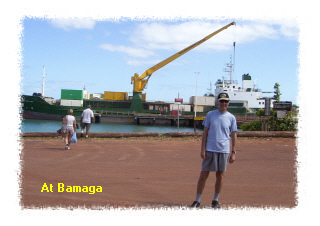 The settlement of Seisia is located some 6 km north of Bamaga and overlooks the
islands of the Torres Strait. Seisia was established in 1948, when members of the
Saibai Island Koedal Clan moved to Cape York in a pearling lugger called "Seisia."
The name Seisia was derived from the first letter of the names of six brothers whose sons
called the lugger after them. Their names were Sumai, Elu, Ibuai, Sagankaz, Isaa and Aken.
The settlement of Seisia is located some 6 km north of Bamaga and overlooks the
islands of the Torres Strait. Seisia was established in 1948, when members of the
Saibai Island Koedal Clan moved to Cape York in a pearling lugger called "Seisia."
The name Seisia was derived from the first letter of the names of six brothers whose sons
called the lugger after them. Their names were Sumai, Elu, Ibuai, Sagankaz, Isaa and Aken.
Bamaga itself - see map -
is the administrative centre for the three Aboriginal communities of
Injinoo, Umagico and New Mapoon, as well as the Torres Strait Islander communities
of Seisia and Bamaga. Bamaga had been established by the Department of Native Affairs
after Saibai Island had been devastated by a tidal wave and Saibai Islanders, led by a
man called Bamaga, moved to the mainland of Cape York.
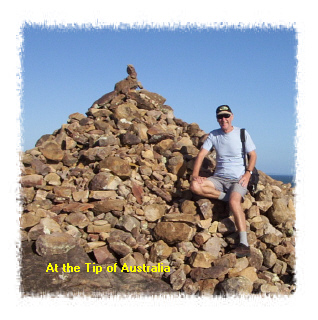 I had booked on what was supposed to be a 32-km half-day trip by four-wheel drive to the tip
of Australia. It turned out to be little more than a quick bouncey ride in a Bamaga
taxi driving by Bill, a disgruntled, diarrhoetic white who derided everything from the local aborigines to
life in the far north. He told us everything about himself and next to nothing about the
landscape we were racing through, and unceremoniously dropping us at a small beach, he
pointed us "That way" across some boulders
towards the northern-most tip of Australia.
He urged us to be back within the hour as he seemed to have better things to do than
drive southern tourists through the scrub.
We scrambled up the slope and down again to
arrive at a cairn which I took to be "it", the tip of the mainland.
People had climbed this hill and added a stone or two to the cairn at the top,
if only to prove that there is nothing really damn stupid that humans won't do.
Somehow the northernmost tip of Australia was anti-climactic; sometimes, travelling hopefully is better than arriving. For travellers who come up
from Cooktown by road, it's the bumps and dips and corrugations - teeth-chattering, nerve-jangling, and bum-aching -
that remain most vividly in their memory. As one T-shirt , bought in Cooktown, pointedly stated,
"The Top, just 6,952,000 corrugations away". Incredible to think that
as long ago as 1928, a baby Austin Seven from Sydney, sponsored by Shell Spirit and Oils,
and Dunlop Tyres, became the first car to reach the tip! These days an estimated 400 to 500 vehicles
make the journey each year, even though the roads are impassable during the wet season.
I had booked on what was supposed to be a 32-km half-day trip by four-wheel drive to the tip
of Australia. It turned out to be little more than a quick bouncey ride in a Bamaga
taxi driving by Bill, a disgruntled, diarrhoetic white who derided everything from the local aborigines to
life in the far north. He told us everything about himself and next to nothing about the
landscape we were racing through, and unceremoniously dropping us at a small beach, he
pointed us "That way" across some boulders
towards the northern-most tip of Australia.
He urged us to be back within the hour as he seemed to have better things to do than
drive southern tourists through the scrub.
We scrambled up the slope and down again to
arrive at a cairn which I took to be "it", the tip of the mainland.
People had climbed this hill and added a stone or two to the cairn at the top,
if only to prove that there is nothing really damn stupid that humans won't do.
Somehow the northernmost tip of Australia was anti-climactic; sometimes, travelling hopefully is better than arriving. For travellers who come up
from Cooktown by road, it's the bumps and dips and corrugations - teeth-chattering, nerve-jangling, and bum-aching -
that remain most vividly in their memory. As one T-shirt , bought in Cooktown, pointedly stated,
"The Top, just 6,952,000 corrugations away". Incredible to think that
as long ago as 1928, a baby Austin Seven from Sydney, sponsored by Shell Spirit and Oils,
and Dunlop Tyres, became the first car to reach the tip! These days an estimated 400 to 500 vehicles
make the journey each year, even though the roads are impassable during the wet season.
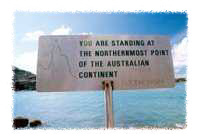 A few intrepid
souls of our group struggled a bit farther down the hill and, as they told me later, discovered the
actual sign which reads, "YOU ARE STANDING AT THE NORTHERNMOST POINT OF THE AUSTRALIAN
CONTINENT." Damn it, so I'd missed that one! After that, it was almost too much
to listen to another one of Bill's tirades all the way back to Seisia. At $65 each,
or a total of $390 for six passengers, Bill had been paid rather handsomely for divesting himself of his
hatred of the Aborigines and his singularly boring life's story! A few intrepid
souls of our group struggled a bit farther down the hill and, as they told me later, discovered the
actual sign which reads, "YOU ARE STANDING AT THE NORTHERNMOST POINT OF THE AUSTRALIAN
CONTINENT." Damn it, so I'd missed that one! After that, it was almost too much
to listen to another one of Bill's tirades all the way back to Seisia. At $65 each,
or a total of $390 for six passengers, Bill had been paid rather handsomely for divesting himself of his
hatred of the Aborigines and his singularly boring life's story!
|
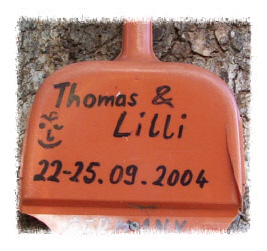
Others seemed to have done better and spent quite some time at the Tip if Thomas and Lilli's
sign, nailed to a tree, seemed anything to go by. And indeed, they were many more interesting
places to explore and hear about: the now closed Pajinka Wilderness Lodge, the historic settlement
of Somerset and nearby cave paintings, the fishing lodge at Punsand Bay, and several other
places of interest along the track. As it happened, I now knew almost everything
there was to know about the most boring duffer in northern Australia and very little
about Cape York.
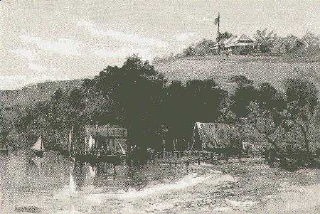 And yet Cape York has had a very interesting history:
22 km north of Bamaga a few gravestones, some rusting iron fences, collapsed walls and
remnant plantations are pretty much all that remains of a grandiose scheme - tackled primarily by the
pioneer Frank Jardine and his wife, a Samoan princess - to create a "Singapore of the South Pacific".
The settlement was established in 1863 by John Jardine who had visions of the town eventually becoming
a major port to rival Singapore. Jardine had been appointed police
And yet Cape York has had a very interesting history:
22 km north of Bamaga a few gravestones, some rusting iron fences, collapsed walls and
remnant plantations are pretty much all that remains of a grandiose scheme - tackled primarily by the
pioneer Frank Jardine and his wife, a Samoan princess - to create a "Singapore of the South Pacific".
The settlement was established in 1863 by John Jardine who had visions of the town eventually becoming
a major port to rival Singapore. Jardine had been appointed police
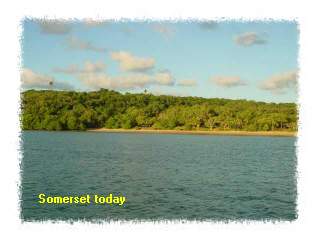 magistrate and gold commissioner of Rockhampton in 1861 and in 1863 he became the government
resident in Somerset. While he had the good sense to sail up the coast his sons, Frank and Alexander, set off from
Rockhampton to overland cattle to the new settlement. They departed on 14 May 1864 and arrived
at Somerset on 2 March 1865. On the way they were harassed by Aborigines and spent most of their
time hacking their way through jungles and traversing swamps. By the time they reached Somerset the
42 horses and 250 cattle they had started with had been reduced to 12 horses and 50 cattle.
Frank Jardine went on to marry Sana Solia, the niece of the King of Samoa, and when the settlement
at Somerset was moved to Thursday Island in 1877 he stayed on as a kind of tropical lord holding
elaborate banquets for any passing visitors. He died of leprosy in 1919. Sana died four years later.
For years afterwards, ships passing the old residency would fire a salute.
Pinney & Runcie's book "Too Many Spears" tells of this fascinating
time in the history of Cape York.
magistrate and gold commissioner of Rockhampton in 1861 and in 1863 he became the government
resident in Somerset. While he had the good sense to sail up the coast his sons, Frank and Alexander, set off from
Rockhampton to overland cattle to the new settlement. They departed on 14 May 1864 and arrived
at Somerset on 2 March 1865. On the way they were harassed by Aborigines and spent most of their
time hacking their way through jungles and traversing swamps. By the time they reached Somerset the
42 horses and 250 cattle they had started with had been reduced to 12 horses and 50 cattle.
Frank Jardine went on to marry Sana Solia, the niece of the King of Samoa, and when the settlement
at Somerset was moved to Thursday Island in 1877 he stayed on as a kind of tropical lord holding
elaborate banquets for any passing visitors. He died of leprosy in 1919. Sana died four years later.
For years afterwards, ships passing the old residency would fire a salute.
Pinney & Runcie's book "Too Many Spears" tells of this fascinating
time in the history of Cape York.
|
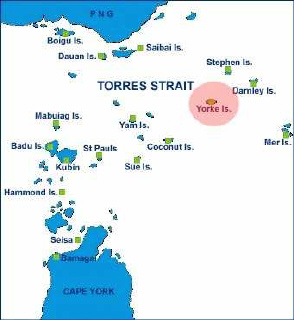 On leaving Seisia, we were told that we wouldn't proceed direct to Cairns
but make a long detour to Yorke Island
to rendezvous with the prawnfishing fleet's mothership, the MV Emu Bay, which had
several hundred cartons of frozen prawns for us to take back to Cairns. This would
delay our return to Cairns from midday Wednesday to early Thursday morning.
Luckily I hadn't booked my return flight out of Cairns for Wednesday afternoon!
So everybody settled in for another sunset on the high seas! I tried to have my
medicinal gin and tonic bulk-billed on my Medicare Card but Adrienne, the hostess, refused.
Still, bar prices were fairly reasonable and they did accept VISA-card.
On leaving Seisia, we were told that we wouldn't proceed direct to Cairns
but make a long detour to Yorke Island
to rendezvous with the prawnfishing fleet's mothership, the MV Emu Bay, which had
several hundred cartons of frozen prawns for us to take back to Cairns. This would
delay our return to Cairns from midday Wednesday to early Thursday morning.
Luckily I hadn't booked my return flight out of Cairns for Wednesday afternoon!
So everybody settled in for another sunset on the high seas! I tried to have my
medicinal gin and tonic bulk-billed on my Medicare Card but Adrienne, the hostess, refused.
Still, bar prices were fairly reasonable and they did accept VISA-card.
Yorke Island had been settled by "Yankee Ned" Mosby in the 1870s, and most of the island's
present-day inhabitants claimed to be his descendants. Mosby was an American sailor believed
to have been born in Baltimore in 1840. Making his way to Sydney on a Yankee whaler, he
jumped ship and was soon master of his own lugger, working the rich reefs of the Torres
Strait for mother-of-pearl, bêche-de-mer, and hawksbill turtle. After running off
with an island woman named Queenie, he settled on Yorke. In the course of expanding his
business, Yankee Ned began westernising life on the island, even engaging the services of a
European teacher for its school. In later life Yankee Ned was badly injured by a stingray.
His leg became infected and had to be amputated in the hospital at Thursday Island. Hobbling
around in the tropical climate on his wooden peg leg, wearing a white beard, a black
cowboy hat, and a necktie, he was known to everyone on T.I., where he did in 1911.
<=== previous page
next page ===>
|
|

 On leaving Seisia, we were told that we wouldn't proceed direct to Cairns
but make a long detour to Yorke Island
to rendezvous with the prawnfishing fleet's mothership, the MV Emu Bay, which had
several hundred cartons of frozen prawns for us to take back to Cairns. This would
delay our return to Cairns from midday Wednesday to early Thursday morning.
Luckily I hadn't booked my return flight out of Cairns for Wednesday afternoon!
So everybody settled in for another sunset on the high seas! I tried to have my
medicinal gin and tonic bulk-billed on my Medicare Card but Adrienne, the hostess, refused.
Still, bar prices were fairly reasonable and they did accept VISA-card.
On leaving Seisia, we were told that we wouldn't proceed direct to Cairns
but make a long detour to Yorke Island
to rendezvous with the prawnfishing fleet's mothership, the MV Emu Bay, which had
several hundred cartons of frozen prawns for us to take back to Cairns. This would
delay our return to Cairns from midday Wednesday to early Thursday morning.
Luckily I hadn't booked my return flight out of Cairns for Wednesday afternoon!
So everybody settled in for another sunset on the high seas! I tried to have my
medicinal gin and tonic bulk-billed on my Medicare Card but Adrienne, the hostess, refused.
Still, bar prices were fairly reasonable and they did accept VISA-card.
 The ship travelled through the night and arrived at Seisia in the early hours of
Monday morning. We had breakfast on board before being allowed ashore. The jetty
at Seisia lays claim to be "Australia's Best Fishing Jetty." The locals
certainly believed in it and had their lines out well before the day had turned too hot.
The ship travelled through the night and arrived at Seisia in the early hours of
Monday morning. We had breakfast on board before being allowed ashore. The jetty
at Seisia lays claim to be "Australia's Best Fishing Jetty." The locals
certainly believed in it and had their lines out well before the day had turned too hot.
 The settlement of Seisia is located some 6 km north of Bamaga and overlooks the
islands of the Torres Strait. Seisia was established in 1948, when members of the
Saibai Island Koedal Clan moved to Cape York in a pearling lugger called "Seisia."
The name Seisia was derived from the first letter of the names of six brothers whose sons
called the lugger after them. Their names were Sumai, Elu, Ibuai, Sagankaz, Isaa and Aken.
The settlement of Seisia is located some 6 km north of Bamaga and overlooks the
islands of the Torres Strait. Seisia was established in 1948, when members of the
Saibai Island Koedal Clan moved to Cape York in a pearling lugger called "Seisia."
The name Seisia was derived from the first letter of the names of six brothers whose sons
called the lugger after them. Their names were Sumai, Elu, Ibuai, Sagankaz, Isaa and Aken.
 I had booked on what was supposed to be a 32-km half-day trip by four-wheel drive to the tip
of Australia. It turned out to be little more than a quick bouncey ride in a Bamaga
taxi driving by Bill, a disgruntled, diarrhoetic white who derided everything from the local aborigines to
life in the far north. He told us everything about himself and next to nothing about the
landscape we were racing through, and unceremoniously dropping us at a small beach, he
pointed us "That way" across some boulders
towards the northern-most tip of Australia.
He urged us to be back within the hour as he seemed to have better things to do than
drive southern tourists through the scrub.
We scrambled up the slope and down again to
arrive at a cairn which I took to be "it", the tip of the mainland.
People had climbed this hill and added a stone or two to the cairn at the top,
if only to prove that there is nothing really damn stupid that humans won't do.
Somehow the northernmost tip of Australia was anti-climactic; sometimes, travelling hopefully is better than arriving. For travellers who come up
from Cooktown by road, it's the bumps and dips and corrugations - teeth-chattering, nerve-jangling, and bum-aching -
that remain most vividly in their memory. As one T-shirt , bought in Cooktown, pointedly stated,
"The Top, just 6,952,000 corrugations away". Incredible to think that
as long ago as 1928, a baby Austin Seven from Sydney, sponsored by Shell Spirit and Oils,
and Dunlop Tyres, became the first car to reach the tip! These days an estimated 400 to 500 vehicles
make the journey each year, even though the roads are impassable during the wet season.
I had booked on what was supposed to be a 32-km half-day trip by four-wheel drive to the tip
of Australia. It turned out to be little more than a quick bouncey ride in a Bamaga
taxi driving by Bill, a disgruntled, diarrhoetic white who derided everything from the local aborigines to
life in the far north. He told us everything about himself and next to nothing about the
landscape we were racing through, and unceremoniously dropping us at a small beach, he
pointed us "That way" across some boulders
towards the northern-most tip of Australia.
He urged us to be back within the hour as he seemed to have better things to do than
drive southern tourists through the scrub.
We scrambled up the slope and down again to
arrive at a cairn which I took to be "it", the tip of the mainland.
People had climbed this hill and added a stone or two to the cairn at the top,
if only to prove that there is nothing really damn stupid that humans won't do.
Somehow the northernmost tip of Australia was anti-climactic; sometimes, travelling hopefully is better than arriving. For travellers who come up
from Cooktown by road, it's the bumps and dips and corrugations - teeth-chattering, nerve-jangling, and bum-aching -
that remain most vividly in their memory. As one T-shirt , bought in Cooktown, pointedly stated,
"The Top, just 6,952,000 corrugations away". Incredible to think that
as long ago as 1928, a baby Austin Seven from Sydney, sponsored by Shell Spirit and Oils,
and Dunlop Tyres, became the first car to reach the tip! These days an estimated 400 to 500 vehicles
make the journey each year, even though the roads are impassable during the wet season.
 A few intrepid
souls of our group struggled a bit farther down the hill and, as they told me later, discovered the
actual sign which reads, "YOU ARE STANDING AT THE NORTHERNMOST POINT OF THE AUSTRALIAN
CONTINENT." Damn it, so I'd missed that one! After that, it was almost too much
to listen to another one of Bill's tirades all the way back to Seisia. At $65 each,
or a total of $390 for six passengers, Bill had been paid rather handsomely for divesting himself of his
hatred of the Aborigines and his singularly boring life's story!
A few intrepid
souls of our group struggled a bit farther down the hill and, as they told me later, discovered the
actual sign which reads, "YOU ARE STANDING AT THE NORTHERNMOST POINT OF THE AUSTRALIAN
CONTINENT." Damn it, so I'd missed that one! After that, it was almost too much
to listen to another one of Bill's tirades all the way back to Seisia. At $65 each,
or a total of $390 for six passengers, Bill had been paid rather handsomely for divesting himself of his
hatred of the Aborigines and his singularly boring life's story!
 And yet Cape York has had a very interesting history:
22 km north of Bamaga a few gravestones, some rusting iron fences, collapsed walls and
remnant plantations are pretty much all that remains of a grandiose scheme - tackled primarily by the
pioneer Frank Jardine and his wife, a Samoan princess - to create a "Singapore of the South Pacific".
The settlement was established in 1863 by John Jardine who had visions of the town eventually becoming
a major port to rival Singapore. Jardine had been appointed police
And yet Cape York has had a very interesting history:
22 km north of Bamaga a few gravestones, some rusting iron fences, collapsed walls and
remnant plantations are pretty much all that remains of a grandiose scheme - tackled primarily by the
pioneer Frank Jardine and his wife, a Samoan princess - to create a "Singapore of the South Pacific".
The settlement was established in 1863 by John Jardine who had visions of the town eventually becoming
a major port to rival Singapore. Jardine had been appointed police
 magistrate and gold commissioner of Rockhampton in 1861 and in 1863 he became the government
resident in Somerset. While he had the good sense to sail up the coast his sons, Frank and Alexander, set off from
Rockhampton to overland cattle to the new settlement. They departed on 14 May 1864 and arrived
at Somerset on 2 March 1865. On the way they were harassed by Aborigines and spent most of their
time hacking their way through jungles and traversing swamps. By the time they reached Somerset the
42 horses and 250 cattle they had started with had been reduced to 12 horses and 50 cattle.
Frank Jardine went on to marry Sana Solia, the niece of the King of Samoa, and when the settlement
at Somerset was moved to Thursday Island in 1877 he stayed on as a kind of tropical lord holding
elaborate banquets for any passing visitors. He died of leprosy in 1919. Sana died four years later.
For years afterwards, ships passing the old residency would fire a salute.
Pinney & Runcie's book "Too Many Spears" tells of this fascinating
time in the history of Cape York.
magistrate and gold commissioner of Rockhampton in 1861 and in 1863 he became the government
resident in Somerset. While he had the good sense to sail up the coast his sons, Frank and Alexander, set off from
Rockhampton to overland cattle to the new settlement. They departed on 14 May 1864 and arrived
at Somerset on 2 March 1865. On the way they were harassed by Aborigines and spent most of their
time hacking their way through jungles and traversing swamps. By the time they reached Somerset the
42 horses and 250 cattle they had started with had been reduced to 12 horses and 50 cattle.
Frank Jardine went on to marry Sana Solia, the niece of the King of Samoa, and when the settlement
at Somerset was moved to Thursday Island in 1877 he stayed on as a kind of tropical lord holding
elaborate banquets for any passing visitors. He died of leprosy in 1919. Sana died four years later.
For years afterwards, ships passing the old residency would fire a salute.
Pinney & Runcie's book "Too Many Spears" tells of this fascinating
time in the history of Cape York.